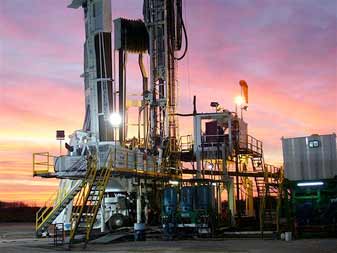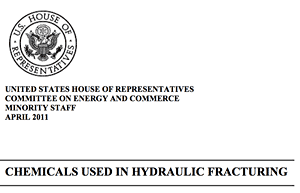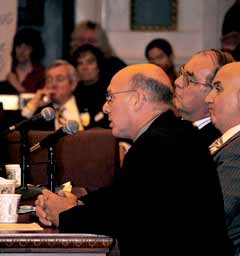Biblio
Climate change issues bring into greater prominence that all the world's people are linked together and that we all have a stake in creating a sustainable path for the planet and no such path can allow for 10 million avoidable child deaths each year.
--Kirk Smith, UC Berkeley, School of Public Health
Whatever your goal (economic growth, stable population democratic institutions, global equity, art, literature, science, an educated electorate, etc.), it is impaired by excess child mortality.
Malnutrition is the single most important risk factor for child mortality. According to Kirk Smith, "each of [its'] separate causes is thought to be increased by both climate change itself and, potentially, by efforts to combat climate change through biofuel expansion [and] energy price rises."
Professor Smith’s research addresses the relationships among environmental quality, health, resource use, development, and policy in developing countries, and the implications for policy of the potential to achieve co-benefits (health and climate) from pollution control in developing countries.
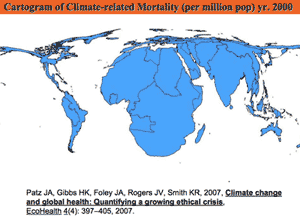
"One of the few positive sides of the climate change crisis is that the global village is no longer just an intellectual construct.
That we have one planet, one atmosphere, one set of mutual responsibilities, and one fate – these are now clear."

Thank you Professor Smith. I ask, what is the value of a human life? Climate change is going to kill millions of children, does it matter that they're not yours?
The value of a life in the United States is a factor in the quality of regulation and enforcement of the Clean Air Act, the Clean Water Act, and climate change policy initiatives that may not survive the Climate Zombies of the U.S. Congress.
As Washington and our insurance companies estimate an individual life's value at around 4 to 6 million dollars, the warrant for increased regulation of toxic industry seems more justified. Yet, the oil and gas industry and their government advocates still question the legal authority of the EPA and U.S. congress to enact and enforce environmental regulations as they relate to both climate change and the enormous consumption of water associated with hydraulic fracturing.
There are sociological and economic impacts of an unregulated energy industry. A tightly connected global ecosystem depends more and more on both a food and water supply that has become more privatized, making it difficult for self-sustaining indigenous farming to succeed.
One week's worth of food by various cultures:
Hundreds of millions of children are slated to die already, mostly by starvation, because of our present inaction.
The oil and gas industry has shown no evidence that it is ready or capable of self-regulation. It becomes an increasing threat to the health of humanity. (Neil Zusman. 2011-02-24)
"The exploitation of fossil fuels is integral to modern living and has been a key element of the rapid technological, social, and cultural changes of the past 250 years. Although such changes have brought undeniable benefits, this exploitation has contributed to a burden of illness through pollution of local and regional environments, and is the dominant cause of climate change.
This pattern of development is therefore unsustainable at a global level. At the same time, about 2·4 billion of the world’s population, disadvantaged by lack of access to clean energy, are exposed to high levels of indoor air pollutants from the inefficient burning of biomass fuels." (Wilkinson, 2007).
Smith, K. R, and E. Haigler. “Co-benefits of climate mitigation and health protection in energy systems: scoping methods.” Public Health 29 (2008): n. pag. Print.
Smith K.R., "Mitigating, Adapting, and Suffering: How Much of Each?", (Symposium on Climate and Health, KR Smith, ed), Annual Review of Public Health 29 (2008): 23. Print.
Wilkinson, Paul. et al. “A global perspective on energy: health effects and injustices.” The Lancet 370.9591 (2007): 965-978. Web.
See: Appelbaum, Binyamin. “A Life’s Value May Depend on the Agency, but It’s Rising.” The New York Times 16 Feb. 2011. Web. 17 Feb. 2011.
See also: Associated Press. "How to value life? EPA devalues its estimate: $900,000 taken off in what critics say is way to weaken pollution rules." 2008-07-10.
Climate Ground Zero started out as a campaign against oil and tar sands in Montana and Canada. Upon requests by local activists working to end mountaintop removal coal mining, Climate Ground Zero moved to Rock Creek, West Virginia.
Coal River Mountain was the last mountain to remain untouched by mountaintop removal mining in the Coal River Valley. Climate Ground Zero’s direct action campaign took off when Coal River Mountain was clear-cut in preparation for mountaintop removal in February of 2009. Since then over 150 people have been arrested in various actions on Coal River Mountain and other mountaintop removal sites in West Virginia.
Climate Ground Zero is not an environmental organization; it is an ongoing campaign of non-violent civil resistance in southern West Virginia to end mountaintop removal. Here at Climate Ground Zero we believe that the irrevocable destruction of the mountains of Appalachia and its accompanying toll on the air, water, and lives of Appalachians necessitates continued and direct action.
In West Virginia, an overwhelming majority of residents are opposed to mountaintop removal mining. However, political interests are highly invested in the coal industry and the EPA and the West Virginia DEP refuse to take real action to protect the environment and the people of West Virginia.
In order to stop mountaintop removal, we need to awaken the country to the devastation that mountaintop removal inflicts on one of the most biodiverse regions in the world, Appalachia, and its people. Since Climate Ground Zero came to West Virginia in 2009, hundreds of activists have come to the coalfields and stood with the residents of West Virginia to demand an end to the destruction.
Climate Ground Zero is a project of the American Forest Alliance and works in cohesion with Mountain Justice, a regional network of organizations in Kentucky, Tennessee, Virginia, and West Virginia, that seek the abolition of mountaintop removal in Appalachia and throughout the country.
July 25, 2009
Alexa Jay. December 2, 2010. Climate Science Watch. "Final hearing of the House global warming committee: 'a fight that is far from over'".
“There is growing evidence from the real world that climate changes are accelerating faster than we originally feared and that impacts—already appearing—will be more widespread and severe than expected. This makes the arguments against taking actions against climate change not just wrong, but dangerous,” Dr. Gleick said in his written testimony.
See: Tara Lohan. Feb. 19, 2009. Alternet. "Peter Gleick: How We Can Avoid a World Without Water". Interview with Peter Gleick.
Rick Piltz. Nov. 1, 2009. "On 'Editing Scientists' at the White House Council on Environmental Quality".
Scientific American contrasts CEQ chair Nancy Sutley’s stated position on science and policy at the White House with what we observed, reported, and documented under her Bush-Cheney CEQ predecesors, and what the House Oversight and Government Reform Committee discovered in its lengthy investigation initiated after we leveled our charge. “My role here and CEQ’s role is to advise the president on environmental policy,” says Sutley. “The science is what the science is…I am not editing science.”
When Nancy Sutley moved in to her new office as chair of the Council on Environmental Quality (CEQ)—a 40-year-old White House environmental policy advisory office created by Congress—she found a lot of red pens. Immediately, she removed the pens from her desk and asked her staff to remove any red pens from their desks, as well.
“The White House should not be in the business of editing science,” Sutley says. “Let the scientists do the science. It’s a really easy bright line for me.”
Rick Piltz is the Founder and Director of Climate Science Watch
Rick has worked as an educator, writer, and policy analyst and advocate since the 1970’s, in federal and state government, academia, and nonprofit organizations. During his more than 20 years in Washington, his primary focus has been on the collision of climate science with the reality of climate politics and policy.
From 1995-2005 he held senior positions in the Coordination Office of the U.S. Global Change Research Program. In the spring of 2005, Rick resigned from his position to protest the Bush Administration’s political interference with climate change communication. His whistleblower documentation of politically motivated White House editing and censorship of climate science program reports intended for the public and Congress received front-page coverage in the New York Times and was widely reported in the media. Rick testified before both the House of Representatives and the Senate at hearings on political interference with federal climate scientists.
See: Whistleblower.org
See: Public Supports Consumer and Environmental Protections, Polls Show
The incoming Republican chairs of the House of Representatives plan to send the United States back to the Stone Age with respect to climate policy. All of them opposed the climate legislation supported by President Barack Obama, and now oppose limits on global warming pollution under the Clean Air Act. Several have accused climate scientists of doctoring data and suppressing dissent; the others merely claim climate policy is actually a conspiracy to destroy the American economy. Meet the climate zombies who will be in charge of developing all federal legislation for the next two years:
SENATE
HOUSE
See: Grist. Dec. 29, 2010. "Upton argues Obama plans to destroy America in the name of global warming."
US coal mining companies have scored some points in their fight against the Environmental Protection Agency’s tough stance on mountaintop mining. A federal judge has ruled (PDF) in a preliminary decision that the EPA may have overstepped its legal authority by imposing strict new environmental standards on mining permits (via New York Times). The move comes just one day after the agency vetoed a permit for what would have been the country's largest mountaintop coal mine in Appalachia, West Virginia (see Nature’s blog here).
See: Ken Ward Jr. "Breaking news: EPA vetoes Spruce Mine permit." Coal Tattoo. Jan. 13, 2011.
From Publishers Weekly
Through vivid first-person reporting and a thorough culling of court transcripts, newspaper clippings and corporate reports, Vanity Fair contributing editor Shnayerson (The Killers Within) has crafted an incriminating indictment of the Appalachian King Coal industry in West Virginia, and of the man he defines as its rapacious kingpin, Massey Energy's CEO, Don Blankenship.
The author's sympathies lie clearly with opponents of mountaintop mining, most prominently young attorney Joe Lovett and citizen activist Judy Bonds. Both have fought against a form of mining that shears off the tops of hills and dumps rubble into valleys and streams—a process abetted by the collusion of the state's often-lackadaisical Department of Environmental Protection, the U.S. Army Corps of Engineers' propensity to grant stream-destroying permits without oversight and the easing of environmental controls by the Bush administration.
Shnayerson's compelling take on toxic mining methods and their heartrending impact on Appalachian inhabitants and their culture, has a wider focus than Erik Reece's 2006 title, Lost Mountain, which reported on one mountaintop's destruction, and strong echoes of the stomach-churning legal machinations recounted in Jonathan Harr's 1995 bestseller, A Civil Action.
See: Michael Shnayerson web page.
See: Marsh Fork Elementary: Journey Up Coal River | A Community and Strip Mining
See: WATER | Aurora Lights. Public Health & Coal Slurry - Water Quality ::: Journey Up Coal River
See: Tree spiker : from Earth First! to lowbagging: my struggles in radical environmental action
See: Leveling Appalachia: The Legacy of Mountaintop Removal Mining
See: Environmental Issues and Challenges in Coal Bed Methane Production
See: Climate Ground Zero
See: Mountaintop Removal
Coalbed methane has rapidly become an important source of natural gas, particularly in the Inter-mountain West. The rapidity of its development has resulted in significant pressure on communities to deal with its environmental consequences.
Coalbed methane production often results in large quantities of water that are released as byproducts of production; in some cases, the water may inundate sensitive arid ecosystems, worsen surface water quality, and diminish undergroundwater supplies.
Noise, dust, and increased traffic; impairment of visibility and conflicts with recreation and other land use; impacts on wildlife and ecosystems; and other consequences of development have generated opposition in many communities.
Particularly vexing has been development on split estates, where surface owners do not own the mineral rights underneath their property and are required to cooperate with development that may disrupt the use and control of their land. This article examines the problems associated with coalbed methane development and offers a variety of suggestions for how conflicts could be reduced and how development could proceed in ways that are ecologically sustainable.
See: Hydraulic Fracturing Background Information | EPA (2004)
The Energy Policy Act passed by Congress in 2005 amended the Safe Drinking Water Act (SDWA) to exclude hydraulic fracturing fluids (except diesel fuel) related to energy production from regulation under the UIC program. States may choose to regulate hydraulic fracturing, however.
See: U.S. Environmental Protection Agency (EPA): Weston Wilson Whistle Blower Letter
See: Drilling Around the Law: Drinking Water Threatened by Toxic Natural Gas and Oil Drilling Chemicals
See: Hydraulic Fracturing of Oil and Gas Wells
See: Black Warrior Riverkeeper | Coalbed Methane
There are over four thousand coalbed methane wells in the Black Warrior River watershed. Tens of thousands of acres are leased to this practice, creating a massive network of roads and well pads. The extraction of coalbed methane involves a process known as hydraulic fracturing.
The Black River Watershed in Alabama provides water to over a million people.
See: Orion Magazine. November/December 2006. Taking On Goliath: Across the West, gas development is devastating land and people. | Now citizens are fighting back.
Urgent Action on Water Withdrawal - see "Action" page
CPNY is a coalition of individuals and groups dedicated to halting the dangerous, destructive practice of high-volume hydrofracking for methane gas in our region.
This unconventional method of gas extraction is a huge and looming intrusion that signifies the industrialization of our area now rich in tourism, agriculture, recreational areas, wineries, and open spaces. We must defeat fracking to protect our families, the environment, our property values — indeed, our very way of life.
Our Vision: We say YES to that which promotes the health and vibrancy of our land, our resources, and ourselves. Our vision, like our work, is evolving.
Our Mission: Working together with other like-mined people and organizations, we aim to stop fracking before it gains a foothold in New York State. We inform, educate, and empower people to resist company directors, state and federal officials and all who frack our legislatures, and our public discourse.
We use the term “fracking” to mean all the processes involved in exploring, developing, extracting, disposing, storing, and distributing shale gas via high-volume, slick-water horizontal and vertical drilling, and secondarily but equally importantly to denote the “fracturing” of our health, environment, and communities.
We also do not use the term "natural" gas in regards to shale gas. The only natural state for gas trapped within shale rock deep in the ground underlying New York State is to remain where it is - serving as bedrock. The term "natural," like many other carefully chosen terms used by the extraction industry, is intended to give the false impression that shale gas is a benign and "clean, green" fuel, when in fact its extraction via this unconventional method, is as or more dirty than coal.
Eighteen Republican members of the Colorado State Legislature Monday sent a letter (pdf) to the U.S. Environmental Protection Agency (EPA) demanding the federal agency refrain from regulating the natural gas drilling practice of hydraulic fracturing, or “fracking,” no matter what a two-year EPA study of the process reveals.
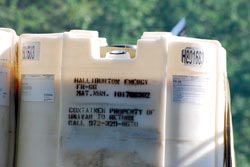
Halliburton frac fluid on a tractor trailer near Buffalo, Pa. Source: Marcellus-Shale.us
See: Christoper Hayes. The Rachel Maddow Show on MSNBC: Fossil Fuel Follies, at 2:22.
Photographs by Jacques del Conte
More than 15 million people, including residents of New York City and Philadelphia, get their water from its pristine watershed.
To regard its unspoiled beauty on a spring morning, you might be led to believe that the river is safely off limits from the destructive effects of industrialization. Unfortunately, you’d be mistaken.
The Delaware is now the most endangered river in the country, according to the conservation group American Rivers.

A V.F. video look at a town transformed by fracking.
That’s because large swaths of land—private and public—in the watershed have been leased to energy companies eager to drill for natural gas here using a controversial, poorly understood technique called hydraulic fracturing. “Fracking,” as it’s colloquially known, involves injecting millions of gallons of water, sand, and chemicals, many of them toxic, into the earth at high pressures to break up rock formations and release natural gas trapped inside.
Sixty miles west of Damascus, the town of Dimock, population 1,400, makes all too clear the dangers posed by hydraulic fracturing. You don’t need to drive around Dimock long to notice how the rolling hills and farmland of this Appalachian town are scarred by barren, square-shaped clearings, jagged, newly constructed roads with 18-wheelers driving up and down them, and colorful freight containers labeled “residual waste.”
See: Dimock Natural Gas Drilling.
See: Cabot Oil & Gas.
See: Dark Side of a Natural Gas Boom.
See: Before/After Drilling (video).
Apr 16, 2011
Today Energy and Commerce Committee Ranking Member Henry A. Waxman, Natural Resources Committee Ranking Member Edward J. Markey, and Oversight and Investigations Subcommittee Ranking Member Diana DeGette released a new report that summarizes the types, volumes, and chemical contents of the hydraulic fracturing products used by the 14 leading oil and gas service companies.
The report contains the first comprehensive national inventory of chemicals used by hydraulic fracturing companies during the drilling process.
“Hydraulic fracturing has helped to expand natural gas production in the United States, but we must ensure that these new resources don’t come at the expense of public health,” said Rep. Waxman.
“This report shows that these companies are injecting millions of gallons of products that contain potentially hazardous chemicals, including known carcinogens. I urge EPA and DOE to make certain that we have strong protections in place to prevent these chemicals from entering drinking water supplies.”
See: U.S. Congress. Committee on Energy and Commerce. Minority Staff (Henry Waxman, Edward Markey, Diana DeGette). "Chemicals Used in Hydraulic Fracturing". Washington, D.C. April 2011. (PDF)
Universal Well Services, for example, told the Committee that it “obtains hydraulic fracturing products from third-party manufacturers, and to the extent not publicly disclosed, product composition is proprietary to the respective vendor and not to the Company.”31
Complete Production Services noted that the company always uses fluids from third-party suppliers who provide an MSDS for each product. Complete confirmed that it is “not aware of any circumstances in which the vendors who provided the products have disclosed this proprietary information” to the company, further noting that “such information is highly proprietary for these vendors, and would not generally be disclosed to service providers” like Complete.32
Key Energy Services similarly stated that it “generally does not have access to the trade secret information as a purchaser of the chemical(s).”33
Trican also told the Committee that it has limited knowledge of “off the shelf” products purchased from a chemical distributor or manufacturer, noting that “Trican does not have any information in its possession about the components of such products beyond what the distributor of each product provided Trican in the MSDS sheet.”34
In these cases, it appears that the companies are injecting fluids containing unknown chemicals about which they may have limited understanding of the potential risks posed to human health and the environment.
VI. CONCLUSION
Hydraulic fracturing has opened access to vast domestic reserves of natural gas that could provide an important stepping stone to a clean energy future. Yet questions about the safety of hydraulic fracturing persist, which are compounded by the secrecy surrounding the chemicals used in hydraulic fracturing fluids.
This analysis is the most comprehensive national assessment to date of the types and volumes of chemical used in the hydraulic fracturing process.
It shows that between 2005 and 2009, the 14 leading hydraulic fracturing companies in the United States used over 2,500 hydraulic fracturing products containing 750 compounds. More than 650 of these products contained chemicals that are known or possible human carcinogens, regulated under the Safe Drinking Water Act, or listed as hazardous air pollutants.
31. Letter from Reginald J. Brown to Henry A. Waxman, Chairman, Committee on Energy and Commerce, and Edward J. Markey, Chairman, Subcommittee on Energy and Environment (Apr. 16, 2010).
32. Letter from Philip Perry to Henry A. Waxman, Chairman, Committee Energy and Commerce, and Edward J. Markey, Chairman, Subcommittee on Energy and Environment (Aug. 6, 2010).
33. E-mail from Peter Spivack to Committee Staff (Aug. 5, 2010).
34. E-mail from Lee Blalack to Committee Staff (July 29, 2010).
by Ian Urbina:
Oil and gas companies injected hundreds of millions of gallons of hazardous or carcinogenic chemicals into wells in more than 13 states from 2005 to 2009, according to an investigation by Congressional Democrats.
...“Questions about the safety of hydraulic fracturing persist, which are compounded by the secrecy surrounding the chemicals used in hydraulic fracturing fluids,” said the report, which was written by Representatives Henry A. Waxman of California, Edward J. Markey of Massachusetts and Diana DeGette of Colorado.
...Some of the ingredients mixed into the hydraulic fracturing fluids were common and generally harmless, like salt and citric acid. Others were unexpected, like instant coffee and walnut hulls, the report said. Many of the ingredients were “extremely toxic,” including benzene, a known human carcinogen, and lead.
...Ms. Degette, and Representative Maurice D. Hinchey, Democrat of New York, recently reintroduced the FRAC Act, a bill that would require chemical disclosure from all drilling companies, including a provision that companies release proprietary information to health professionals if it is needed for treatment. The FRAC Act would also create an online registry of chemicals on a well-by-well basis, but it would require drillers to disclose what they plan to use before they fracture a well, as well as a post-fracturing report.
See: Urbina, Ian. “Millions of Gallons of Hazardous Chemicals Injected Into Wells, Report Says.” The New York Times 16 Apr. 2011. Web. 17 Apr. 2011.
See also: Texas Oil and Gas Acciountability Project. The Dark Side of the Boom: How Natural Gas Drilling in Texas Threatens Public Health and Safety: Sen. Lon Burnam Joins Calling for ‘Urgent’ Reforms
Thursday, April 14, 2011
Flowback: How the Texas Natural Gas Boom Affects Health and Safety
TEXAS OIL & GAS ACCOUNTABILITY PROJECT
FOR IMMEDIATE RELEASE: April 14, 2011
The Dark Side of the Boom: How Natural Gas Drilling in Texas Threatens Public Health and Safety: Sen. Lon Burnam Joins Calling for ‘Urgent’ Reforms
AUSTIN, TX, APRIL 14 – State, local and federal officials and regulatory agencies are failing to protect Texans from the health and safety risks of the natural gas boom, according to a report released today by the Texas Oil & Gas Accountability Project (OGAP).
Daniel T. Spadoni. Commonwealth of Pennsylvania Dept. of Environmental Protection (DEP) Press Release. 4/30/2010. "DEP Orders Cabot Oil & Gas Corp. to Remove Hibbard Well Pad Reserve Pit in Susquehanna County: Company Ignored DEP’s Prior Written, Verbal Requests".
WILLIAMSPORT -- The Department of Environmental Protection today ordered Cabot Oil & Gas Corp. to close and remove an earthen pit in Susquehanna County that holds drilling fluids to determine whether it is contaminating nearby water resources.
The pit, known as a reserve pit, is located at the Hibbard well pad in Dimock Township. The company has 14 days to comply with the order.
DEP’s North-central Regional Director Robert Yowell said today’s more aggressive enforcement action was necessitated after the company ignored previous requests.
"DEP strongly advised Cabot to close and remove the reserve pit in an April 8 notice of violation letter and reiterated to Cabot’s senior management the same message a few short days ago," said Yowell. "However, Cabot has not remedied the situation and its inaction demonstrates an arrogant disregard for Pennsylvania’s oil and gas regulations and proper protection of our environment."
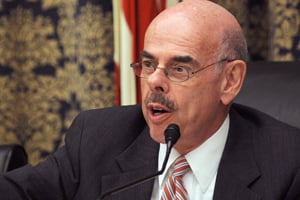
Rep. Henry A. Waxman, D-Calif.
"Two of the largest companies involved in natural gas drilling have acknowledged pumping hundreds of thousands of gallons of diesel-based fluids into the ground in the process of hydraulic fracturing, raising further concerns that existing state and federal regulations don't adequately protect drinking water from drilling."
Source: Energy and Commerce Committee Investigates Potential Impacts of Hydraulic Fracturing
See: New York Times. Conoco, BP, Caterpillar Leave Climate Coalition. Feb. 16, 2010.
ConocoPhillips, Caterpillar Inc. and BP America have left the U.S. Climate Action Partnership, a coalition of more than two-dozen companies and environmental groups lobbying Congress to pass greenhouse gas emissions cap-and-trade legislation.
From Conoco Phillips Web Page: Remediation
We give serious attention to our duty to restore properties impacted by our operations. Our responsibility for remediation can arise from prior contamination on properties we subsequently acquired, contamination of properties we currently own, or contamination of previously owned properties for which we retained individual or joint responsibility for cleanup.
We completed remediation on more than 300 sites in 2008, and currently are restoring more than 3,600 properties in various locations around the world.
See: Report: Marcellus Shale Drillers Amass 1435 Violations in 2.5 Years
The Pennsylvania Land Trust Association has reviewed environmental violations accrued by Marcellus Shale drillers working in Pennsylvania between January 2008 and June 25, 2010. The records were obtained via a Right to Know Request made to the PA Department of Environmental Protection (DEP).
The Pennsylvania Land Trust Association seeks to protect Pennsylvania’s special places and landscapes for today and for generations to come.
To increase the quality and pace of land conservation, PALTA helps conservation practitioners improve their effectiveness, builds public understanding, and advocates for better governmental policy.
See also: Drilling in the Marcellus Shale | Academy of Natural Sciences
In April, 2010, the Academy's Center for Environmental Policy presented a public panel discussion, “The Marcellus Shale – The Science and the Policy.” Video of this program is available on our website.
Dr. David Velinsky testifying before the City
Council of Philadelphia on the environmental
impacts of drilling in the Marcellus Shale.
On September 28, 2010, Dr. David Velinsky, vice president of the Academy's Patrick Center for Environmental Research, testified before the City Council of Philadelphia about the scientific questions at hand and need for new research. A copy of his testimony is available for download.























